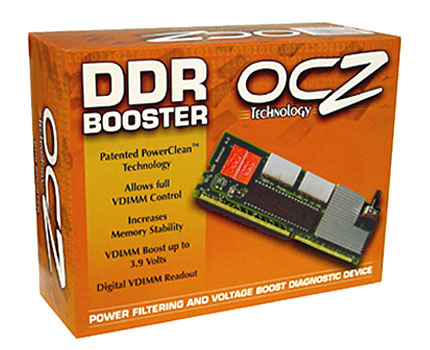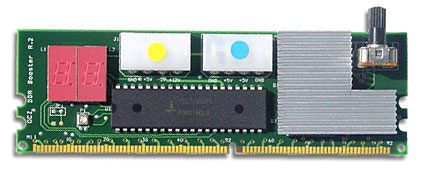OCZ VX Memory + DFI nForce4 = DDR533 at 2-2-2
by Wesley Fink on March 4, 2005 6:45 AM EST- Posted in
- Memory
OCZ EL PC4000 VX Gold
OCZ has developed quite a reputation in the past year with the introduction of many leading-edge memory products. As you will see in a look at our ongoing memory benchmarks, the results have been that OCZ owns many of the top performance spots in our memory tests. Even with that kind of reputation, OCZ VX must be counted a unique product. The EL label is used by OCZ for Extreme Latency, but VX is a new label used to refer to Voltage eXtreme memory. VX means that the memory is designed for and can handle very high memory voltages for expanded performance.The first OCZ VX memory was rated at a very conservative PC3200 2-3-3-8 at a standard 2.6V. While it met these specifications, the specs hardly described a memory that was widely recognized as capable of DDR500 and higher at 2-2-2 timings using voltages of 3.0V and higher. As yields and binning improved, OCZ decided in late February to introduce an updated VX memory - now rated at DDR500 2-2-2 at 3.3V.
The new DDR500 2-2-2 uses the same chips as the earlier VX, but it is binned for higher speed and verified at the new DDR500 specifications. OCZ tells us that everything about the new VX memory is basically the same as earlier PC3200VX, but with even better chips becoming available for VX, it was time for the higher speed rating. OCZ will also be introducing a VX value memory in the future for those enthusiasts that want 2-2-2 timings, but do not demand DDR500+ timings for 2-2-2. Gold VX modules are optimized for use on Athlon 64 based motherboards. In addition, OCZ EL PC-4000 Gold VX is rated to handle up to 3.5V without invalidating the OCZ lifetime warranty.

The new VX DDR500 uses the familiar OCZ Gold heatspreaders. OCZ describes the heatspreaders as gold-mirrored copper, and DDR500 VX is only available as a 1GB kit with two 512MB double-sided memory modules. We removed the heatspreader and found the memory chips were labeled OCZ. OCZ apparently buys memory chip blanks and relabels them for VX. OCZ is usually very open about chip sources, but in this case, they would only comment that the memory chips were made to their specifications and went through extensive binning at OCZ. Forums are claiming that the blank is a new Winbond memory chip.
The recently tested DFI LANParty nForce4 boards are the only current production boards to fully support the voltages required by VX memory. It is fortunate that the DFI are also excellent performers and the DFI LANParty nF4 SLI-DR was the recent winner of our Gold Editors Choice in the nForce4 SLI roundup. The DFI boards are only recently available, however, and prior to the DFIs, there were two ways to use VX memory. First, some enthusiasts modified their boards to supply higher memory voltage.

Second, you could use VX with an OCZ DDR Booster, which is a device designed to fit into the DIMM slot of most motherboards.

The DDR Booster is a little $40 device that allows the user to select voltages up to 3.9V regardless of what voltages the motherboard supports. This neatly gets around the fact that most motherboards supply only 2.7V to 2.85V to the memory slots. For motherboards other than the DFI, you can even buy a bundle of VX memory with the DDR booster.
OCZ EL PC4000 VX Gold Specifications
| OCZ EL PC4000 VX Gold Memory Specifications | |
| Number of DIMMs & Banks | 2 DS |
| DIMM Size Total Memory |
512 MB |
| Rated Timings | 2-2-2-8 at DDR500 at 3.3V 2-3-3-8 at DDR400 at 2.6V (Typically 2-2-2-8 at DDR400 at 3.0V) |
| SPD (Auto) Timings | 3-3-3-8 |
| Rated Voltage | 3.3V |
With Intel's introduction last summer of the Intel 915/925X chipsets with support for DDR2 memory, the primary market for DDR memory has become the excellent AMD Athlon 64 platform. However, some 915 boards also support DDR, and the continuing Intel Socket 478 also supports DDR memory. It is worth noting that OCZ designed PC4000VX for the AMD platform and it is optimized for the Athlon 64 platform. In addition, the only unmodified motherboard for VX is the DFI nForce4 motherboards. For these reasons, OCZ EL PC4000 VX Gold was only tested on the DFI LANParty nF4 SLI-DR Athlon 64 Socket 939 test bed.










67 Comments
View All Comments
theOracle - Saturday, March 5, 2005 - link
sorry, of odes = or does!intirely = entirely
Any ideas when this RAM is available\where from?
theOracle - Saturday, March 5, 2005 - link
Some of the figures show over 10% performance increase (the actual game benchmarks, not just memory benches) - is this performance intirely attributable to the RAM of odes the motherboard\gfx come into play at all?Previously high-end RAM with tight timings has shown an improvement of a couple of fps - say max 2% overall, yet this is showing figures of 10% improvement - which like I say is like going from a 3500+ to a 4000+ - and I'm pretty certain that the DFI board, this ram and a 3500+ would be cheaper than a 4000+, generic ram and a cheaper mobo.
Wesley - can I suggest a follow up, with this RAM on other boards and a direct comparison of RAM on the same setup, because I think the benchmarks you have shown certainly warrant this being done. You cant blame me for being sceptical when the figures are so unbelievably awesome!
Wesley Fink - Saturday, March 5, 2005 - link
#34 - The other RAM did NOT perform identically, it is just that there was much smaller variation in the results than we saw with the leap in VX performance.Perhaps it will be easier to swallow if I point out that the OCZ 3200 Platinum R2, PQI 3200 Turbo, G. Skill TCCD, Geil PC3200 Ultra X, and Corsair TwinX1024-4400C25 are all based on the same Samsung TCCD memory chips. The Crucial Ballistix is based on Micron chips, and the OCZ 3700 Gold R3 is based on Hynix DT-D5 chips. Until VX, all recent memory has had to compete with Samsung TCCD, which quickly became the performance standard for current memory. If we had results from older BH5 chips you would likely have seen BH5 perform between Samsung TCCD and OCZ VX.
Rand - Saturday, March 5, 2005 - link
I find some of these results rather difficult to believe, not so much the results of the OCZ DRAM but I'm confused as to how the other DRAM in this test managed to perform identically in every test on the MSI K8N Neo2 that was used in your last DRAM review and the DFI motherboard utilized in this review.It would seem rather unlikely that every piece of DRAM would perform exactly the same in every test on two different motherboards.
Forsa - Saturday, March 5, 2005 - link
I have the 3200vx and they perform very similarly(i think they are the same ram but just different auto settings lol) I will post screenie and stuff on forums when i can run some concrete bench marks.Live - Friday, March 4, 2005 - link
These are winbond chips that can also be found in twinmos. Dont know if this is mentiond in the article as I did not read all :)Check out this link for info on speeds and which ones to get:
http://www.akiba-pc.com/article.php?45.0
slashbinslashbash - Friday, March 4, 2005 - link
Wesley: I'm confused by your answers to #15/#17. Did you actually test all 8 types of RAM on the DFI LANParty nF4 SLI-DR with nVidia 71.80 drivers, or did you take the benchmark results for the other 7 sticks of RAM from the previous review of the Corsair 4400C25, which used an MSI nF3 motherboard and the 61.77 drivers? (All the numbers seem to be the same, which I find hard to believe with a new motherboard, chipset, and video drivers. I would expect at least a couple of variations of 0.1 fps or something.)Jeff7181 - Friday, March 4, 2005 - link
Awesome... I always wondered about Tras and the Athlon-64... this answers my question! :)Slaimus - Friday, March 4, 2005 - link
These are Winbond chips. The BH/CH-5/6 chips were their own branded chips, while these are unlabelled OEM chips that are sold for relabelling. The supply of the labelled Winbond chips are gone, but there are still plenty of these unlabelled chips.This really gives you an idea of the cartel nature of the memory industry. Small memory makers like Winbond, despite having a superior product, cannot really stay alive in this market of giants.
ozzimark - Friday, March 4, 2005 - link
thanks for the info wes. if it's not too much trouble, how about a test with the VX on the neo2 with a ddr booster? you say that it's just a better performing ram chip, i'd like to believe you, but it really is difficult to swallow.and.. the fact that this ram is so much faster really is piquing my interest, and shows that even if you don't have extreme voltage, this ram may be nice to have for the higher performance at the same speed/timings.
if it doesn't take too much time, i, and i'm sure a few other people, would be very apprecitative of some benches of vx on the neo2. thanks wes.